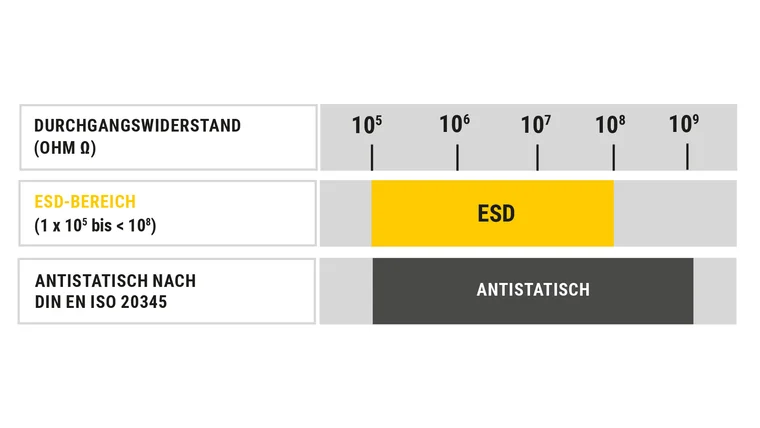ESD - ELECTRO STATIC DISCHARGE
Safety shoes in accordance with EN ISO 20345
In general, all safety shoes are produced according to the specifications of DIN EN ISO 20345. There is no requirement/test for the ESD standard in the norm. Only the antistatic area for safety shoes is defined here.

Antistatic shoes must be used if there is a need to reduce electrostatic charge and at the same time contact with live devices cannot be ruled out. Small electric shocks due to electrostatic discharge are normally not dangerous for people, but can have serious consequences in potentially explosive areas or in case sensitive components are touched.

The contact resistance for all safety shoes is defined in the DIN EN ISO 20345 standard. This must be in the range between greater than 105 ohms (100 kOhm) and less than 109 ohms (1,000 MOhm).

Marking of ESD shoes
The ESD symbol according to DIN EN 61340 is used to identify ESD products. This is not a requirement of the DIN EN ISO 20345 shoe standard. Shoes that are referred to as ESD shoes guarantee an electrical contact resistance of the person-shoe-floor measuring method according to DIN EN 61340-5-1 of <108 ohms (100 MOhm). This serves to protect the product in production and when used in potentially explosive areas.

In principle, ESD shoes have the same safety features as shoes without an ESD symbol. The shoe manufacturer only guarantees the contact resistance defined above. The safety-relevant features are identical for both groups of shoes so that, for example, electricians must also wear ESD safety shoes for their normal activities. A risk assessment of the workplace must be carried out to determine whether additional protective measures have to be taken for work on live systems or components. In DGUV (German Social Accident Insurance) 112-191 for the use of foot and knee protection, the lower value of 105 ohms (0.1 MOhm) is specified as the lowest limit for the resistance of a product in order to guarantee limited protection against the passing of dangerous electrical currents through the body (shocks) in work involving up to 230 V.

